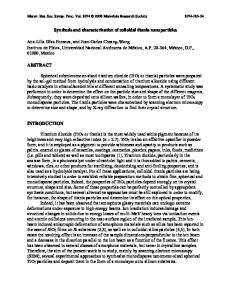Self-assembly of colloidal polymers from two-patch silica nanoparticles
- PDF / 2,252,690 Bytes
- 6 Pages / 612 x 808 pts Page_size
- 91 Downloads / 299 Views
niv. Bordeaux, CNRS, CRPP, UMR 5031, Pessac 33600, France Univ. Bordeaux, CNRS, ICMCB, UMR 5026, Pessac 33600, France 3 Univ. Bordeaux, CNRS, Bordeaux INP, ISM, UMR 5255, Talence 33400, France 2
© Tsinghua University Press and Springer-Verlag GmbH Germany, part of Springer Nature 2020 Received: 3 January 2020 / Revised: 31 July 2020 / Accepted: 1 August 2020
ABSTRACT We report the formation of colloidal polymers consisting of disk-like silica nanoparticles (NPs) with polystyrene (PS) chains at the bottom of their two cavities assembled through reduction of the solvent quality for the PS chains and linked by hydrophobic associations. We show that this NPs assembly exhibits a two-stage process involving reaction-controlled polymerization and diffusion-controlled polymerization. Colloidal polymer networks are produced by the incorporation of three-patch NPs, which serve as branching points between the colloidal chains. By co-assembling preformed homopolymers composed of patchy NPs of different sizes or surface chemical groups, block copolymers are also achieved. This study provides insight into the process of self-assembly of two-patch NPs by precisely designing the components to generate colloidal analogues of linear macromolecular chains.
KEYWORDS colloidal polymers, nanoparticles, patchy, self-assembly
1
Introduction
There are numerous examples of complex structures that result from spontaneous chemical and/or physical processes with no external guidance [1], three-dimensional (3D) structures obtained through proteins folding being one of the most striking. Such a synthetic pathway requires that the instructions that guide the formation of a target structure are distributed among the building blocks, unlike top-down strategies for which the information is stored in a centralized location. A popular way to encode assembly information in colloidal components consists in the regioselective modification of their surface in order to form the so-called patchy particles [2]. A patchy particle is a surface-patterned particle with a controlled number of precisely located chemical or topographic discontinuities acting as favored interaction areas [3]. Patchy particles can form lowdimensional assemblies, such as clusters [4–9], two-dimensional (2D) networks [10] and one-dimensional (1D) chains [11–19]. Indeed, since the pioneer work of Onoe et al. [20], chaining of patchy particles has attracted a lot of attention in the past decade. Murphy and co-workers firstly reported that the density of cetyltrimethylammonium bromide (CTAB) ligands is lower at the tips of gold nanorods making possible to site-specifically bind biotin disulfide and therefore link the NPs end-to-end by adding streptavidin [21]. Kumacheva and co-workers enhanced the patchiness of the CTAB-coated gold nanorods by the functionalization of their tips with thiol-terminated polystyrene (PS) chains, which enabled the formation of linear and cyclic colloidal polymers when dispersed in binary solvent mixtures [22–27]. The driving force of the polymerization of
Data Loading...











